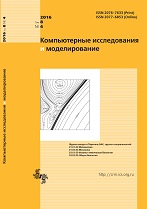|
This article is cited in 2 scientific papers (total in 2 papers)
MODELS OF ECONOMIC AND SOCIAL SYSTEMS
Modeling of population dynamics employed in the economic sectors: agent-oriented approach
M. Yu. Khavinson, A. N. Kolobov
Institute for Complex Analysis of Regional Problems Far Eastern Branch Russian Academy of Sciences,
4 Sholom-Aleikhem st., Birobidzhan, 679016, Russia
Abstract:
The article deals with the modeling of the number of employed population by branches of the economy at the national and regional levels. The lack of targeted distribution of workers in a market economy requires the study of systemic processes in the labor market that lead to different dynamics of the number of employed in the sectors of the economy. In this case, personal strategies for choosing labor activity by economic agents become important. The presence of different strategies leads to the emergence of strata in the labor market with a dynamically changing number of employees, unevenly distributed among the sectors of the economy. Asa result, non-linear fluctuations in the number of employed population can be observed, the toolkit of agent-based modeling is relevant for the study of the fluctuations. In the article, we examined in-phase and anti-phase fluctuations in the number of employees by economic activity on the example of the Jewish Autonomous Region in Russia. The fluctuations found in the time series of statistical data for 2008–2016. We show that such fluctuations appear by age groups of workers. In view of this, we put forward a hypothesis that the agent in the labor market chooses a place of work by a strategy, related with his age group. It directly affects the distribution of the number of employed for different cohorts and the total number of employed in the sectors of the economy.The agent determines the strategy taking into account the socio-economic characteristics of the branches of the economy (different levels of wages, working conditions, prestige of the profession). We construct a basic agent-oriented model of a three-branch economy to test the hypothesis. The model takes into account various strategies of economic agents, including the choice of the highest wages, the highest prestige of the profession and the best working conditions by the agent. As a result of numerical experiments, we show that the availability of various industry selection strategies and the age preferences of employers within the industry lead to periodic and complex dynamics of the number of different-aged employees. Age preferences may be a consequence, for example, the requirements of employer for the existence of work experience and education. Also, significant changes in the age structure of the employed population may result from migration.
Keywords:
employed population, branch of economy, agent-oriented modeling, nonlinear dynamics.
Received: 31.05.2018
Revised: 28.09.2018
Accepted: 28.09.2018
Citation:
M. Yu. Khavinson, A. N. Kolobov, “Modeling of population dynamics employed in the economic sectors: agent-oriented approach”, Computer Research and Modeling, 10:6 (2018), 919–937
Linking options:
https://www.mathnet.ru/eng/crm693 https://www.mathnet.ru/eng/crm/v10/i6/p919
|

| Statistics & downloads: |
| Abstract page: | 178 | | Full-text PDF : | 96 | | References: | 32 |
|




 Contact us:
Contact us: Terms of Use
Terms of Use
 Registration to the website
Registration to the website Logotypes
Logotypes







 Citation in format
Citation in format 
